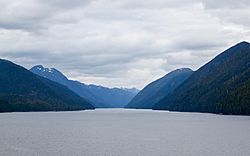Grenville Channel facts for kids
Quick facts for kids Grenville Channel |
|
|---|---|

Grenville Channel
|
|
| Location | North Coast RD, British Columbia |
| Coordinates | 53°37′0″N 129°43′0″W / 53.61667°N 129.71667°W |
| Type | Strait |
| Ocean/sea sources | Pacific Ocean |
The Grenville Channel is a long, narrow waterway located on the North Coast of British Columbia, Canada. It runs between Pitt Island and the mainland. This channel is an important part of the famous Inside Passage, a shipping route used by many boats and ships.
Grenville Channel is about 45 nautical miles (which is about 83 kilometers) long. At its narrowest point, it is only about 0.2 nautical miles (around 0.37 kilometers) wide. The channel is known for its beautiful scenery, with tall mountains and thick forests on both sides.
Contents
Exploring Grenville Channel
Grenville Channel is a natural passage through the land. It connects different parts of the ocean. This makes it very useful for travel and trade.
What is a Strait?
A strait is a narrow natural waterway. It connects two larger bodies of water. Think of it like a natural shortcut for ships. Grenville Channel is a great example of a strait. It helps ships move easily along the coast.
A Busy Waterway: The Inside Passage
The Grenville Channel is a key part of the Inside Passage. This is a protected water route. It stretches along the coast of North America. Many cruise ships, ferries, and cargo vessels use this passage. It offers a calmer journey than the open ocean. This is because islands and the mainland protect it.
How Grenville Channel Was Formed
The landforms around Grenville Channel were created a very long time ago. A fault called the Grenville Channel Fault helped shape it. A fault is like a giant crack in the Earth's crust. Movement along this fault over millions of years created the channel we see today. This process began during the Cretaceous Era. That was the time when dinosaurs roamed the Earth!
Nature Around the Channel
The areas around Grenville Channel are very wild and natural. Both sides of the channel are covered in mountains. These mountains are densely wooded, meaning they have many trees. This environment is home to various types of wildlife. You might spot different birds, marine animals, and land creatures here. The thick forests and calm waters make it a great place for nature to thrive.


